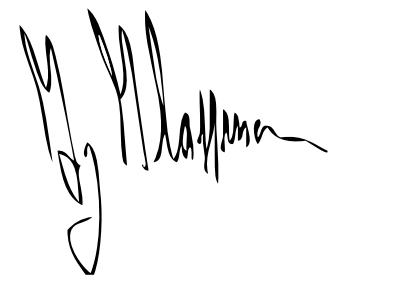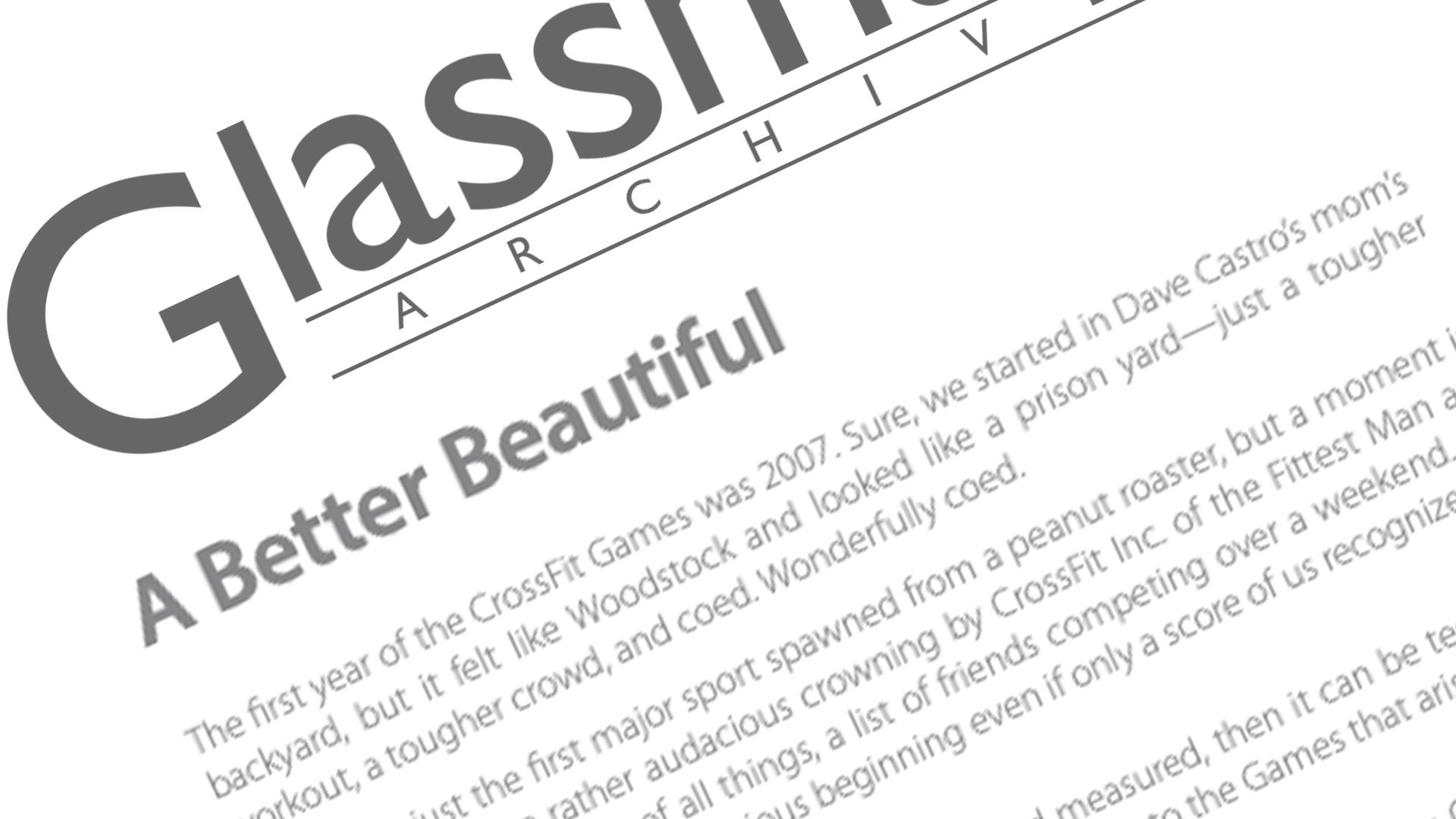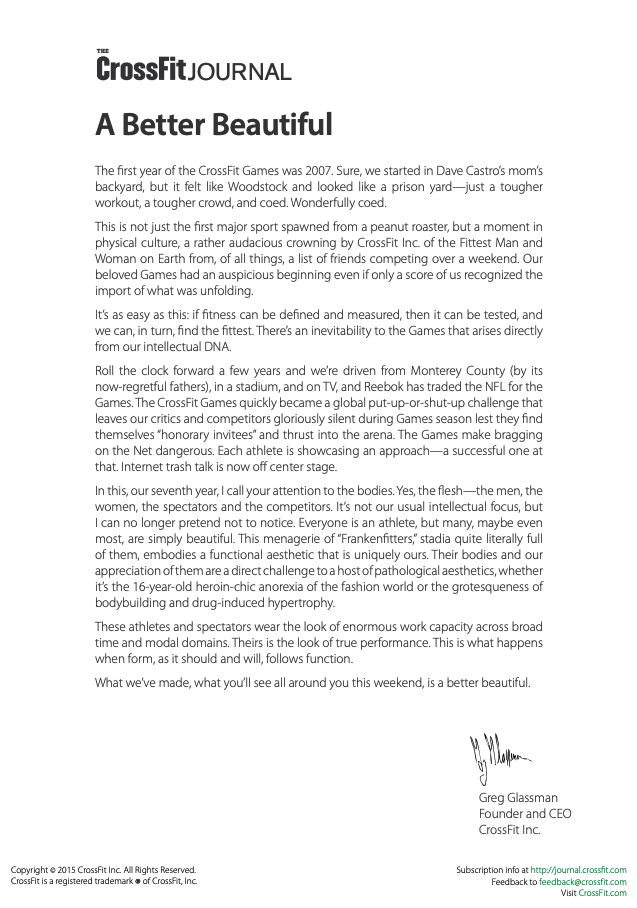Source:
When asked to provide an introduction for the 2013 Reebok CrossFit Games program, CrossFit Inc. Founder Greg Glassman did more than that: He redefined beauty for a new generation of athletes.
“A Better Beautiful” was originally published in July 2013, and we represent it here as a reminder of what’s possible when form follows function.
A Better Beautiful
The first year of the CrossFit Games was 2007. Sure, we started in Dave Castro’s mom’s backyard, but it felt like Woodstock and looked like a prison yard—just a tougher workout, a tougher crowd, and coed. Wonderfully coed.
This is not just the first major sport spawned from a peanut roaster, but a moment in physical culture, a rather audacious crowning by CrossFit Inc. of the Fittest Man and Woman on Earth from, of all things, a list of friends competing over a weekend. Our beloved Games had an auspicious beginning even if only a score of us recognized the import of what was unfolding.
It’s as easy as this: If fitness can be defined and measured, then it can be tested, and we can, in turn, find the fittest. There’s an inevitability to the Games that arises directly from our intellectual DNA.
Roll the clock forward a few years and we’re driven from Monterey County (by its now-regretful fathers), in a stadium, and on TV, and Reebok has traded the NFL for the Games. The CrossFit Games quickly became a global put-up-or-shut-up challenge that leaves our critics and competitors gloriously silent during Games season lest they find themselves “honorary invitees” and thrust into the arena. The Games make bragging on the Net dangerous. Each athlete is showcasing an approach—a successful one at that. Internet trash talk is now off center stage.
In this, our seventh year, I call your attention to the bodies. Yes, the flesh—the men, the women, the spectators and the competitors. It’s not our usual intellectual focus, but I can no longer pretend not to notice. Everyone is an athlete, but many, maybe even most, are simply beautiful. This menagerie of “Frankenfitters,” stadia quite literally full of them, embodies a functional aesthetic that is uniquely ours. Their bodies and our appreciation of them are a direct challenge to a host of pathological aesthetics, whether it’s the 16-year-old heroin-chic anorexia of the fashion world or the grotesqueness of bodybuilding and drug-induced hypertrophy.
These athletes and spectators wear the look of enormous work capacity across broad time and modal domains. Theirs is the look of true performance. This is what happens when form, as it should and will, follows function.
What we’ve made, what you’ll see all around you this weekend, is a better beautiful.

Greg Glassman
Founder
CrossFit Inc.
This article, by BSI’s co-founder, was originally published in The CrossFit Journal. While Greg Glassman no longer owns CrossFit Inc., his writings and ideas revolutionized the world of fitness, and are reproduced here.
Coach Glassman named his training methodology ‘CrossFit,’ which became a trademarked term owned by CrossFit Inc. In order to preserve his writings in their original form, references to ‘CrossFit’ remain in this article.

Greg Glassman founded CrossFit, a fitness revolution. Under Glassman’s leadership there were around 4 million CrossFitters, 300,000 CrossFit coaches and 15,000 physical locations, known as affiliates, where his prescribed methodology: constantly varied functional movements executed at high intensity, were practiced daily. CrossFit became known as the solution to the world’s greatest problem, chronic illness.
In 2002, he became the first person in exercise physiology to apply a scientific definition to the word fitness. As the son of an aerospace engineer, Glassman learned the principles of science at a young age. Through observations, experimentation, testing, and retesting, Glassman created a program that brought unprecedented results to his clients. He shared his methodology with the world through The CrossFit Journal and in-person seminars. Harvard Business School proclaimed that CrossFit was the world’s fastest growing business.
The business, which challenged conventional business models and financially upset the health and wellness industry, brought plenty of negative attention to Glassman and CrossFit. The company’s low carbohydrate nutrition prescription threatened the sugar industry and led to a series of lawsuits after a peer-reviewed journal falsified data claiming Glassman’s methodology caused injuries. A federal judge called it the biggest case of scientific misconduct and fraud she’d seen in all her years on the bench. After this experience Glassman developed a deep interest in the corruption of modern science for private interests. He launched CrossFit Health which mobilized 20,000 doctors who knew from their experiences with CrossFit that Glassman’s methodology prevented and cured chronic diseases. Glassman networked the doctors, exposed them to researchers in a variety of fields and encouraged them to work together and further support efforts to expose the problems in medicine and work together on preventative measures.
In 2020, Greg sold CrossFit and focused his attention on the broader issues in modern science. He’d learned from his experience in fitness that areas of study without definitions, without ways of measuring and replicating results are ripe for corruption and manipulation.
The Broken Science Initiative, aims to expose and equip anyone interested with the tools to protect themself from the ills of modern medicine and broken science at-large.
Support the Broken Science Initiative.
Subscribe today →
recent posts
Medical Society Webinar with David Wiss




